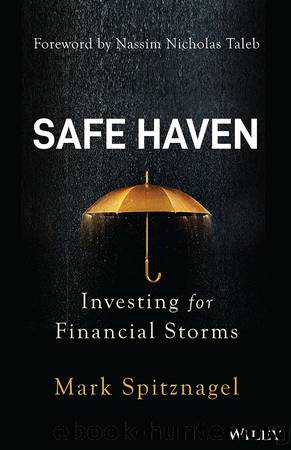Safe Haven by Mark Spitznagel;

Author:Mark Spitznagel; [Spitznagel, Mark]
Language: eng
Format: epub
ISBN: 9781119402510
Publisher: John Wiley & Sons, Inc. (trade)
Published: 2021-07-14T00:00:00+00:00
RISKâMITIGATION IRONY
The big problem with safe havens is they aren't necessarily all that costâeffective. Just because an asset or strategy made the safe haven cut, doesn't necessarily mean that you would have been glad to have it in your portfolio. They are more different than alike, even within each variety.
Safe havens can be exceedingly costly, so much so that, as a cure, they can be worse than the disease. Nietzsche said it best: âWhoever fights monsters should see to it that in the process he does not become a monster.â This is the riskâmitigation irony (and fate loves irony).
Such ironies are a cliché. Take the case of the SS Eastland. In response to the tragedy of the Titanic in 1912, safety regulations were imposed on passenger ships, such as requiring them to carry more lifeboats. This mandatory extra cargo made the SS Eastland exceedingly topâheavy, which caused it to suddenly capsize and sink in the Chicago River in 1915, killing 844 passengers. Ironically, these fatalities exceeded the number of passengers who perished on the Titanic (although the Titanic had many more crew). It is a wellâintentioned though myopic and narrow view that we naturally expect from politicians and bureaucrats. (In The Dao of Capital, I spent a lot of ink on this mistake made by forest rangers and central bankers.) But it's even a common mistake among investors as well. Do somethingâanythingâto mitigate risk, even if it impairs and defeats the purpose; at least you can then say: âWell, I tried.â
The vast majority of presumed safe havens suffer from this same irony. They involve much movement, with little action. And they even do more harm than goodâas monsters in disguise fighting monsters. They simply do not provide very much (if any) portfolio protection at all when it matters; therefore, the only way for them to ever provide meaningful protection is by representing a very large allocation within a portfolio. The problem, then, is that this very large allocation will naturally create a very large cost, or drag, when times are goodâor most of the timeâand even on average. After the dust has settled, you would have likely been safer with no safe haven at all.
Here we see the fundamental difference between a tactical versus a strategic investment, particularly in the context of safe haven investing. A strategic safe haven is about mitigating systematic risk in a portfolio through asset allocations that are more fixed in nature and then letting the dynamic interplay between its parts create the portfolio effect. A tactical safe haven, on the other hand, is about mitigating systematic risk in a portfolio by periodically and actively moving in and out of certain âsafeâ allocations, with the wellâintentioned purpose of saving on the high cost of that safety when times are good. Such a tactical approach to risk mitigation is a very binary one, meaning either âonâ or âoff.â Doing this costâeffectively, by definition, requires timing and shortâterm forecasting skillâyou need a magic crystal ball.
But this is an internal contradiction.
Download
This site does not store any files on its server. We only index and link to content provided by other sites. Please contact the content providers to delete copyright contents if any and email us, we'll remove relevant links or contents immediately.
Zero to IPO: Over $1 Trillion of Actionable Advice from the World's Most Successful Entrepreneurs by Frederic Kerrest(4073)
Machine Learning at Scale with H2O by Gregory Keys | David Whiting(3653)
Harry Potter and the Goblet Of Fire by J.K. Rowling(3615)
Never by Ken Follett(3545)
Ogilvy on Advertising by David Ogilvy(3349)
Shadow of Night by Deborah Harkness(3181)
The Man Who Died Twice by Richard Osman(2818)
Book of Life by Deborah Harkness(2726)
My Brilliant Friend by Elena Ferrante(2707)
How Proust Can Change Your Life by Alain De Botton(2620)
0041152001443424520 .pdf by Unknown(2606)
Will by Will Smith(2589)
The Tipping Point by Malcolm Gladwell(2565)
How to Pay Zero Taxes, 2018 by Jeff A. Schnepper(2505)
Purple Hibiscus by Chimamanda Ngozi Adichie(2501)
Hooked: A Dark, Contemporary Romance (Never After Series) by Emily McIntire(2428)
Rationality by Steven Pinker(2156)
Borders by unknow(2121)
Daughter of Smoke and Bone by Laini Taylor(2086)
